
Every month, when we’re sorting out the run date for this competition, Zach, Vince, and I start taunting one another on Slack. It’s not full-fledged shredding just yet — we save that for the actual article. More of a gentle ribbing. We inevitably brag about our dishes and, usually by mid-cycle, we all know who actually “brought it.”
Truth be told, if I looked back through the series, I could probably find one meal each round where one of the three of us was out of the running because of some unforced error that would never have happened if we’d had a pinch more time, or been in our home kitchens, or had access to the right ingredients.
Not this month. This month everyone brought it. We also all knew that we’d all brought it and, for us at least, that made the month very exciting. Because as you judge our chilis, know that there aren’t any asterisks. There’s no, “I just had a baby!” or “I’m colorblind!” or “I couldn’t find my beloved sous vide!” from your cheftestants.
We all like chili.
We all made chili.
We’re all proud of the chili we made.
Only god can judge us now. And by god, we mean you, the readers. Because if Zach, Vince, and I have one thing in common, it’s that we worship at the altar of outside approval. We’re just three boys, standing in front of some commenters, asking you to love our food.
PAST RESULTS:
BLT Showdown — 1) Vince 2) Zach 3) Steve
Mac & Cheese Showdown — 1) Vince 2) (tie) Zach, Steve
Taco Showdown — 1) Steve 2) Zach 3) Vince
Winter Stew Showdown — 1) Zach 2) Steve 3) Vince
Date Night Showdown — 1) Zach 2) Vince 3) Steve
Pasta Showdown — 1) Steve 2) Zach 3) Vince
Hot Beef Showdown — 1) Zach 2) Vince 3) Steve
Shellfish Showdown — 1) Vince 2) Zach 3) Steve
BBQ Showdown — 1) Steve 2) Zach 3) Vince
Pumpkin Spice Showdown — 1) (tie) Vince, Zach 2) Steve
Thanksgiving Side Dish Showdown — 1) Vince 2) Steve 3) Zach
Christmas Dessert Showdown — 1) Steve 2) Vince 3) Zach
CURRENT SCORE:
We’re giving three points to the winner and one to second place for each round. As it stands, the score is:
ZACH: 18
VINCE: 18
STEVE: 16
Things are heating up, it’s the perfect time for chili!
STEVE’S CHILI COLORADO
I think I’ve told my “that’s when I fell in love with food” origin story about seventeen times; different each time. But chili colorado, if not where I fell in love with food, was certainly when I realized that there was someone behind the curtain, making each dish.
The restaurant was called Chez Jose, in Portland (OR) and it was a trendy Mexican place at a time when most of the other Mexican joints in Portland were holes-in-the-wall. Still, this was the 90s. The plates still had rice and beans, portioned off in sections; everything was just a little more sophisticated.
Anyway, I ordered the chili colorado one day and… it was just so new to me, flavor-wise. Richer and deeper than the Mexican food I’d known up until then. I fell in love with that dish. It was my “If this is out there, think how much MORE is out there!!!” culinary moment. It was the kind of food that told me to go out and be somebody.
So that’s what I’ve prepared for you. Childhood nostalgia meets deep savory flavors. My culinary sweet spot.

If I win this challenge on any single level, it’s the focus on actual chilis. My dish has no beans, no tomatoes, nothing to build a chili around besides chilis. Here are the ones I used:
- Pasilla
- California
- New Mexico (called the “colorado” chili in Mexico)
- Arbol
Note that these chilis aren’t about to shatter at the slightest touch. I went to the Mexican grocer, where they go through their dried chilis quickly; rather than buying them at a mainstream store, where they sit idle for ages. The chili should have some moisture in it and be pliable. (Pretty solid set up for a joke about Vince’s family members, please score points accordingly.)
I toasted the chilis and some onion quarters in olive oil then soaked them in hot beef broth for about 30 minutes. During that time, I moved onto the meat.
I used sirloin, which is a little fattier and more marbled then chuck. Naturally, I trimmed the silver skin, tendon, and fat ribbons that would feel distracting/weird to eat.

Next, I tossed the meat chunks in Mexican oregano, salt, pepper, and finally flour.

Finally, I cooked them up in a smoking hot pan — in batches, so that they’d get a sear.

I’m not a particularly anxious person, but my paranoia about searing these off in a different pan than I was cooking my chili in — thereby losing juices — was torn straight from a psychological thriller. To combat that, I put the meat aside to rest and deglazed my pan (plus the toasted garlic) with more broth, then poured that into a blender with the softened chilis.
Next, I buzzed them down within an inch of their lives.

This next step is crucial. If I hadn’t done it, my chili would have been intolerably spicy. Even for me.
I strained the chili/ garlic/ onion puree into a dutch oven, over my beef.
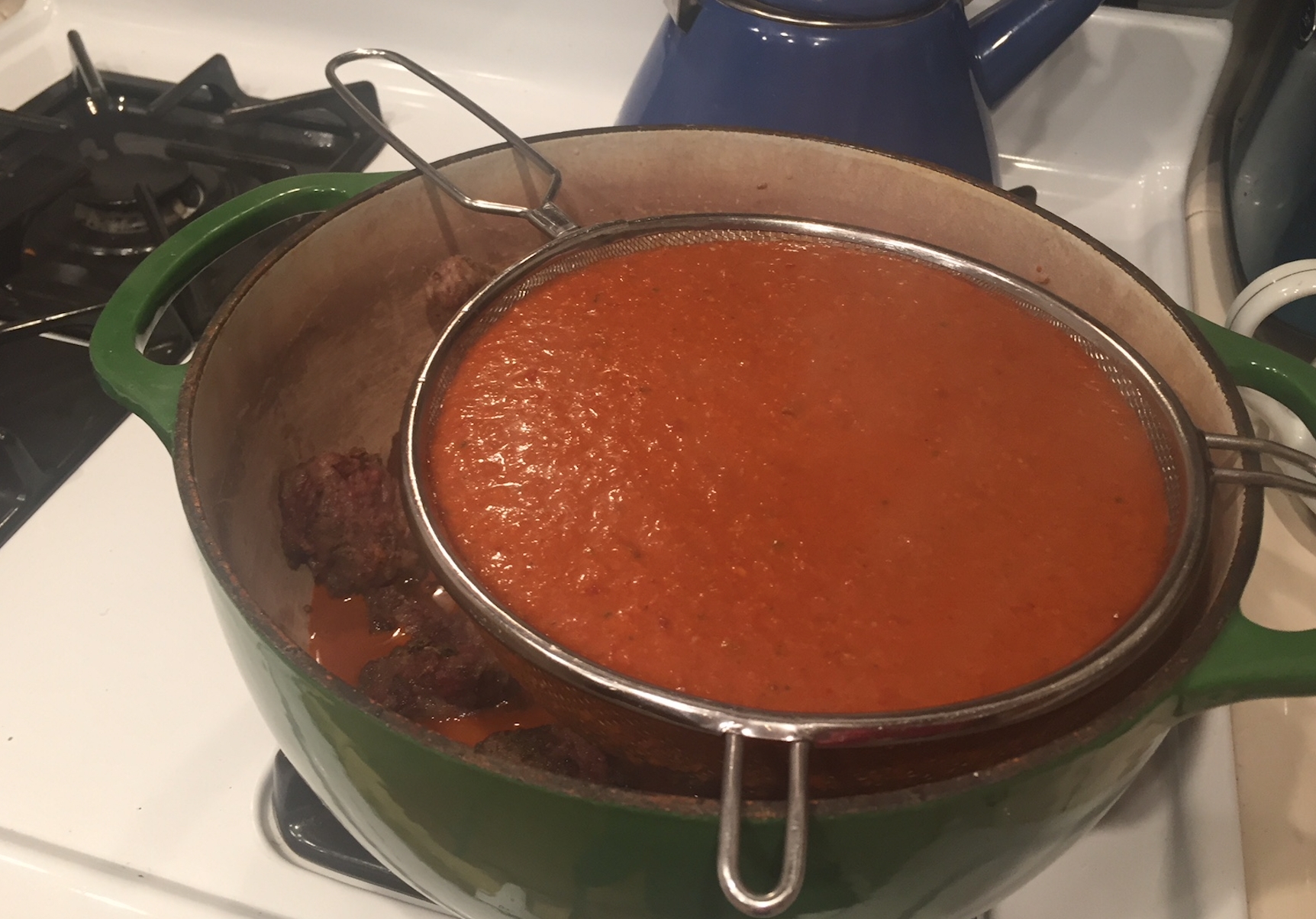
The paste left in the sieve was pure heat. To be clear: No human alive could have enjoyed the chili had I left the pulp in. Instead, I jarred it — so that I’ll have it to parcel out through the month. The chili without the pulp was extremely mild, so I knew I’d have to add a spoonful of the paste back later, but I was glad to have control of the spice level at this stage.

I chopped an onion in big, loose pieces, added some cumin, and let that baby bubble.
For.
A nice.
Little.
While.

I wasn’t trying to make shredded beef, but I let it go until firm pressure with my wooden spoon could split a beef chunk. What can I say, I’m a Cali surfer who drinks green juice: I don’t like to overwork my teeth.
While the chili bubbled, I made flour tortillas. The recipe is insanely simple: flour, water, salt, baking powder, lard.

Oh, don’t mind that adorable baby in the background. I’m cooking over here.
Five years ago, I was taking a cooking class in San Miguel de Allende, Mexico and bought a tortilla press. This week, I learned that my tortilla press is a tourist gimmick. It wasn’t heavy duty enough to get the tortillas paper thin.
I ended up having to roll them out, which left them irregularly shaped. Whatever.
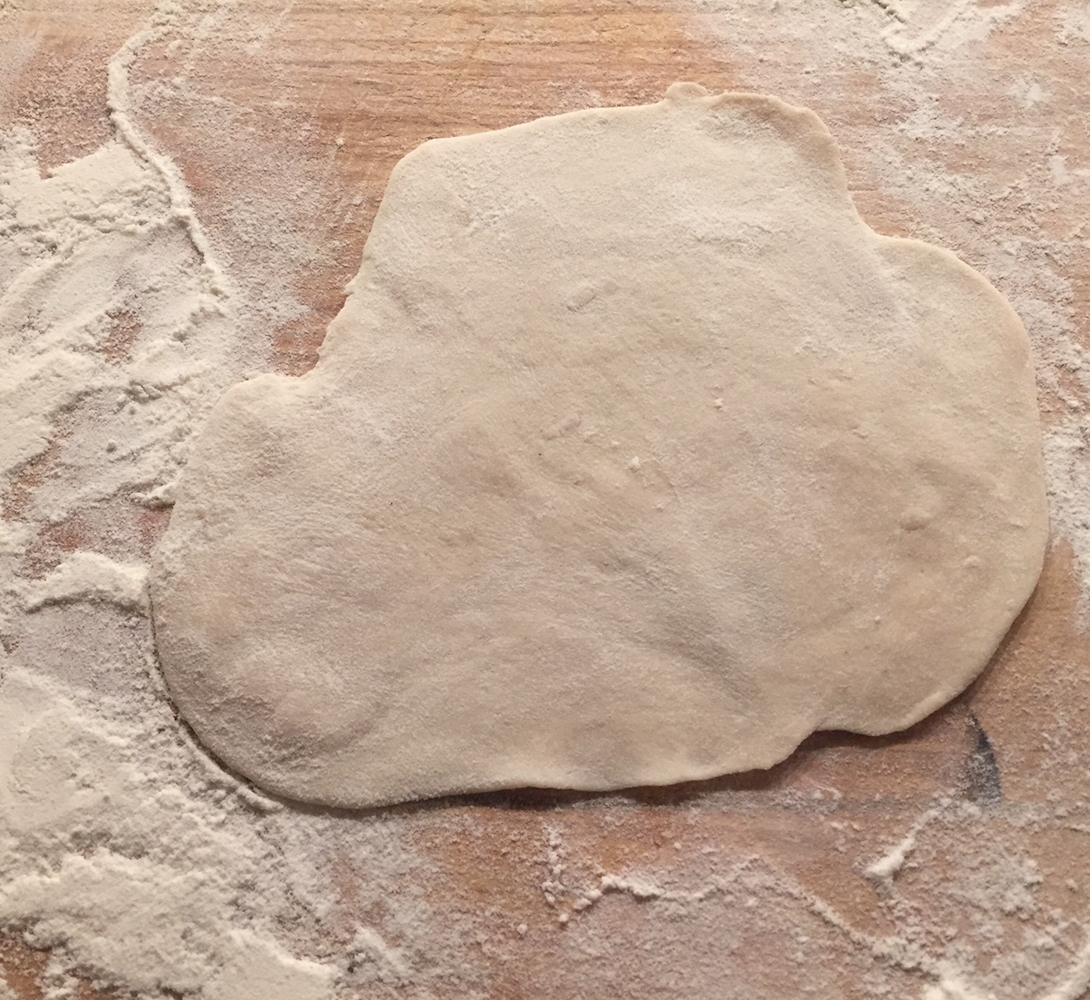
Then I toasted them, and — here’s the Portland in me — I made a little quesadilla with Tillamook 10 year white cheddar. I didn’t use much cheese because I really liked the flavor of the tortillas (turns out lard makes things taste awesome!) and wanted to leave it alone. It was just a little melty sharp element.

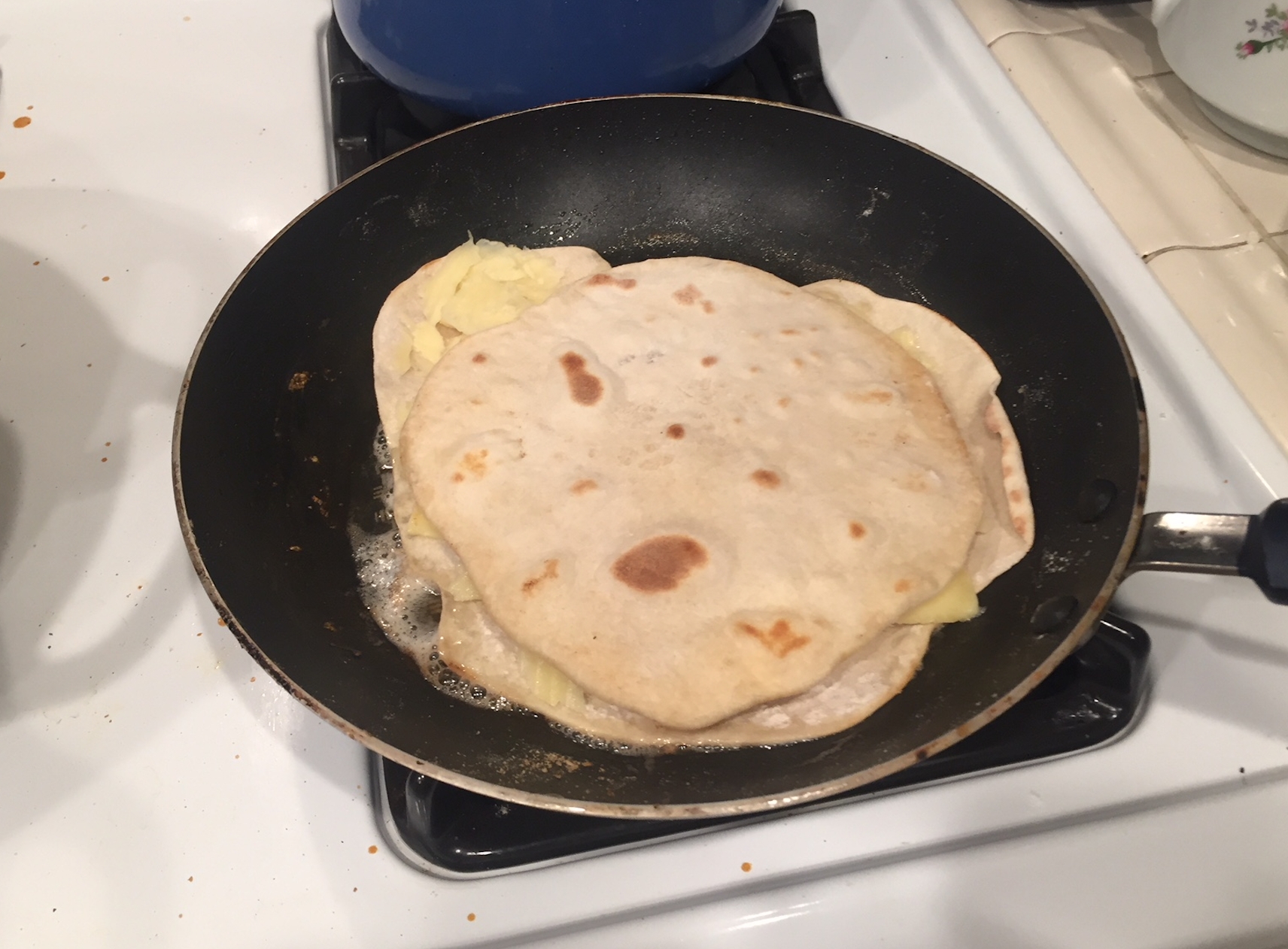
Before the chili was ready, I was ready for some spice and added back in some of my strained chili paste.
Finally, it was time to plate. I needed a cream to brighten everything up and used Oaxacan cream. This is an Oaxacan dish and I wanted to stay true to that. Also… have you had Oaxacan cream? It’s practically a buttermilk cream cheese — thick and slightly funky and a little sour. Better for this dish than a thinner crema Mexicana.
At this point, I remembered that I’d tossed shallots in the oven to crisp at the beginning of the night and I snipped them over the chili with some cilantro. Then salt flake and pepper, a few delicate slices of ripe avo, and it’s ready for your mouth.

This is the closest I’ll ever come to serving something which I believe people can pretty much taste through their screens.
Vince on Steve’s Chili:
Well la di da, check out the commercial blender on Steve. Wedding present, bro? I normally like to nitpick Steve to death for his love of grass clippings and carrot slivers, but Chile Colorado is the second chili possibility that came to mind on this challenge and I almost made it myself. I want to rip on the tortilla press thing too, but I had basically the same experience, only with corn. I mean don’t get me wrong, that tortilla looks like the tortilla equivalent of the Habsburg Jaw (inbred cousin-f*cking ass tortilla) but tortilla shape ain’t that important, especially if you’re just using them as a chili spoon.
Also, that’s a whooole lot of arbol chiles for one dish, but I guess I believe your sieve story (I’ve used six arbols in a salsa before and destroyed my asshole). I guess my biggest criticism is: how about some goddamn cheese? I’d never complain about avocado, even when it seems kind of superfluous, but no cheese on top? I guess you put your “10 year Tillamook” (who brags about Tillamook? is this an Oregon thing?) in the quesadillas, but… whatever, f*ck you.
Zach on Steve’s Chili:
Dude. This is probably the most streamlined Steve dish of the series. There’s no fat here, literally in some cases. Yet there are still those head-scratching Steve choices. Like, why, oh, why use a different pan for searing when you have that beautifully seasoned and aged stew pot you used later? Why so much wheat flour. I get the wheat tortillas are a choice. But, did you have no cornmeal in the house to dredge the beef in?
Also, dude, that flour tortilla is a hilarious shape. Who taught you to roll, yo? I guess, though, the next tortilla turned out way more circular if your latch-key-kid quesadilla is any indication.
But, dude, you completely lost me when you strained out your chili paste. That just seems like a grave error on the level of making risotto with water instead of stock. I mean, you made your chili with a chili-infused beef broth instead of the chilis! It looks good in the end, but, man, was that a shocking choice.
Also, in one classic Steve move, you put on avocados. Isn’t that just superfluous fat on the sour cream that’s already there? Seems very on brand for Steve.
VINCE’S SMOKED CHILE VERDE WITH CORN TORTILLAS

I grew up in California, so I don’t know chili so much as “chile.” I figure the best way to decide which chili to cook is to ask yourself which you’re most precious about. I was going start this making fun of all the regions of the country being precious about their local chili — most versions of which sound stupid and look disgusting to anyone who didn’t grow up there (lookin’ at you, Cincinnati) — but with the benefit of a moment’s reflection, I realized I’m just as precious with my chile verde.
It’s one of those regional dishes you don’t realize is regional until you leave. And I didn’t even go that far! But I remember arriving at college in San Diego and being shocked that for all the otherwise amazing Mexican food (I will defend the California burrito ’til I breathe my last) it was surprisingly hard to find chile verde, which had always been my go-to order (find you a place that will make a California burrito with chile verde — that’s the ticket). One time I ordered chile verde at a restaurant in San Diego and they brought me carnitas with tomatillo salsa on top. I had to be physically restrained.
I won’t say that this is the definitive version of the dish, or even that I learned it from someone who knew what they were doing. All I know is that Juanitos in Reedley, California formed my memory of what chile verde should taste like, and I’ve spent a good 20 years trying to reverse engineer their recipe. This is that, plus some fun with a smoker.
The Meat

I’ve always used pork butt (shoulder) or country style pork ribs. My butcher was out of the latter the week I did this so I went with the butt.
Butcher into small cubes, separating as much of the fat as the possible.
Season the meat. I used salt, cumin, black pepper, and paprika, and I season at least 24 hours ahead of time.
SEMI-LENGTHY DIGRESSION ALERT: For all you dummies who think salting the meat ahead of time is going to dry it out, I don’t want to hear it. You’re wrong. Stop spreading your lies. Relevant passage from Salt Fat Acid Heat:
Many people believe that salt dries and toughens food. But with time, salt will dissolve protein strands into a gel, allowing them to absorb and retain water better as they cook. […] By disrupting the protein structure, salt prevents the [protein] coil from densely coagulating, or clumping, when heated, so more of the water molecules remain bound. The piece of meat remains moister, and you have a greater margin of error for overcooking.
The Base

1 pound tomatillos
3-4 Anaheim chiles
2-3 Jalapeños
1 whole head of garlic
Cilantro and lime to finish
There are a few different ways to do this, but one of the easiest ways I’ve found is that I just put everything into my stove-top smoker. I used to char the chiles on a gas stove or in a broiler, but with the smoker, I can just throw everything in there at the same time and it gets a great smoky flavor. Note: The number of Anaheims and jalapeños varies depending on how hot they are. Sometimes they’re super hot, other times they’re as mild as bell peppers.

Additional Note: If that seems like a lot of garlic, keep in mind that the garlic comes out of the smoker much milder than raw garlic, nutty flavored and with the texture of cream cheese. You can honestly use it as a sandwich spread. I love it.


Anyway, I smoke everything until it’s good and soft and starting to blacken (adding more char on the peppers with the blowtorch where needed). Since we’re using fresh chiles, you have to peel and seed them after you smoke them. But after that, you can just throw everything into a big blender (add lime and cilantro — a good cup or two).
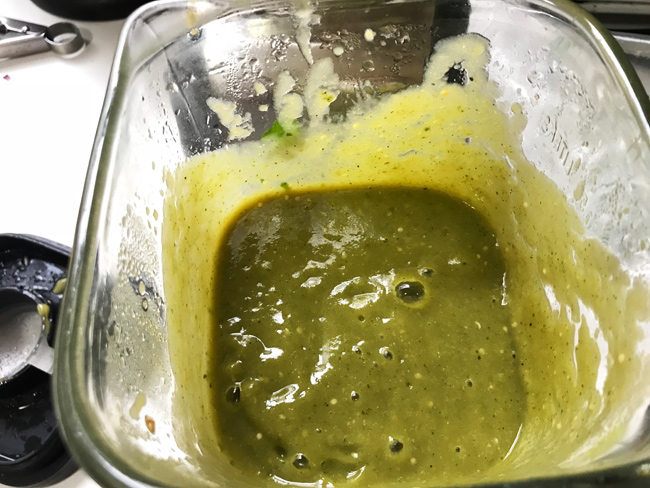
Now we have our spicy-tangy-garlicky base.
The Cook
Start the cook while you’re making the chile base by putting all those butchered fatty bits into a pot over low heat with some water (the water will start the rendering process and eventually burn off, giving you light, rendered fatty bits that have in effect been blanched first). Those will turn into delicious chicharrones that we’ll garnish our dish with at the end (also you can eat them while you cook).

Now that you have that hot rendered fat in the pot, brown the seasoned pork cubes and set aside.
Add two finely diced onions to that pot of hot fat (something, something your mom) and cook until they start to get gooey (those onions are your sweetness).
Once the onions are cooked, I add a tablespoon or two of flour to brown with the onions and fat, just so we get a nice velvety texture at the end. Once that’s done, you can add back in your browned meat and your chile base, plus about 2-4 cups of chicken stock. You can simmer this on the stove, or, since I have a nice cast iron dutch oven, just stick it in the oven at about 325-degrees and leave it for 3-4 hours.
The Garnish


Chili is all about garnish. I normally wouldn’t put much on my chile verde, but since we’re making chili and not burritos I decided to go nuts. With a chili you want to customize. I used:
- Some red onions I pickled
- The chicharrones
- Queso fresco (I swear to God if any of you commenters complain about my crumbly cheese I’m going to drive to your house and break your stuff. Queso fresco is the perfect garnishing cheese, I will not back down)
- Cilantro
I also served it with some home-made corn tortillas. It’s kind of like a Mexican version of chili and cornbread. It’s not red and it doesn’t have a lot of those dry spices people seem to like in chili, but, man, for my money, it’s pretty hard to beat braised pork shoulder in rich tangy green sauce. Falling apart tender pork, rich, tangy, nutty, garlicky sauce. Bon appetit, guey.
[Late Update Pic — Steve complained that he couldn’t see chicharrónes, so here’s a closer version with an Instagram filter]

Zach on Vince’s Chili:
Frankly, I’m amazed Vince didn’t serve this over spaghetti. I was hoping for a Cincinnati-central Valley hybrid abomination.
My biggest critique is why isn’t there a bushel of cilantro in the base sauce? The herbs in the base add a depth that feels like is missing here. I know it says you put lime and cilantro in the blender, but it looks more like an afterthought than a component. And why use flour instead of masa to thicken? Seems like a missed chance to really tie things together taste-wise.
I guess my next biggest problem with this New Mexican dish is that it feels way more like a taco or burrito filling than a chili stew. Like, is there any way you’re not just straight up making tacos with this, especially since it’s served with corn tortillas? I feel like chili should be stew, not a build your own taco. That’s not to say I wouldn’t eat this all day — even if your garnish level is set to eleven even according to the Bramucci garnish scale. Gee, Vince, do you want any chile with that garnish?
Steve on Vince’s Chili:
I’d like to note that Zach pinged me for using flour in my chili and flour tortillas; then pinged Vince for using corn for the tortillas but not masa to thicken. I’m not trying to shame Zach’s pedantic ass, I’m stalling for time and trying to underscore the fact that we all brought the ruckus this month. The burns are the most easy impeachable part of this whole competition.
Hmmmm…. errors (besides my personal taste buds, which prefer something deeper and less “fresh” tasting, but aren’t a legit critique):
- That chili is freaking buried. I’m not going after your mostly flavorless cheese, I don’t know if a more flavorful cheese fits with how tangy that dish looks, I’m just saying it’s a… thorough dusting.
- Where are the chicharrones you spoke of? I WAS PROMISED CHICHARONES!
- Cilantro that size is getting caught in my giant horse teeth.
- Why are the servings so small? I agree with you earlier: Needs to be part of a Cali Burrito. As a bowl, this just feels so grassy and tangy.
But what the hell do I know? I mean, major errors… not sure I see them. I’d wrap this up in one of my misshapen flour tortillas and eat it for days.
ZACH’S TEJANO VENISON CHILI

Chili has a long and storied history. In the early 1800s, bricks of meat, fat, and chilis were pounded into bars as trail food. It was preserved, transportable, and easily reconstituted in a pot of boiling water. Basically that old-school chili bar was a small step from the indigenous super-food pemmican (that’s an ancient power bar made of meat, fat, and some sort of fruit).
Cut to San Antonio’s rail station in the late 1800s. Tejanos (early Texans of Spanish, Canarian, and indigenous descent) sold chili con carne to passengers going to-and-fro. It was a chili stew, usually with venison and served with some beans and corn flatbread on the side, if you were a big spender with a big appetite. From that train station, chili spread across America and by 1900 there were as many versions of chili as there were chili joints.
My recipe is a throwback to those old days at the San Antonio train station. I’m making a Tejano venison chili with lard pinto beans on the side and a buffalo cheese corn cake with some pickled onions and chili pepper for good measure. For me, reconnecting with a native foodway — even though it’s a thousand miles away from my tribes — is a part of embracing the restoration of indigenous cuisine.
The Beans

I don’t have a problem with putting the beans right in the stew. There’s no point in getting uptight about shit like that. But, there’s something to be said for having a lush chili stew with beans on the side, availible if you want them. But, oh boy, those beans better be fucking legit.
For these ones, I soak about a pound of pintos in just-boiled water for about an hour. I dice a medium yellow onion and sweat that in a dollop of pork lard with a good punch of sea salt. (Fair warning, there’s going to be a lot of lard in this recipe.)
Once the onions are translucent, I add in the beans, 34 ounces of chicken stock, and a teaspoon of each smoked paprika, cumin, garlic powder, and allspice. Bring that to a simmer and let it bubble away on a medium to low-ish heat until the beans are cooked through. That’s all you really have to do.
The Venison Chili
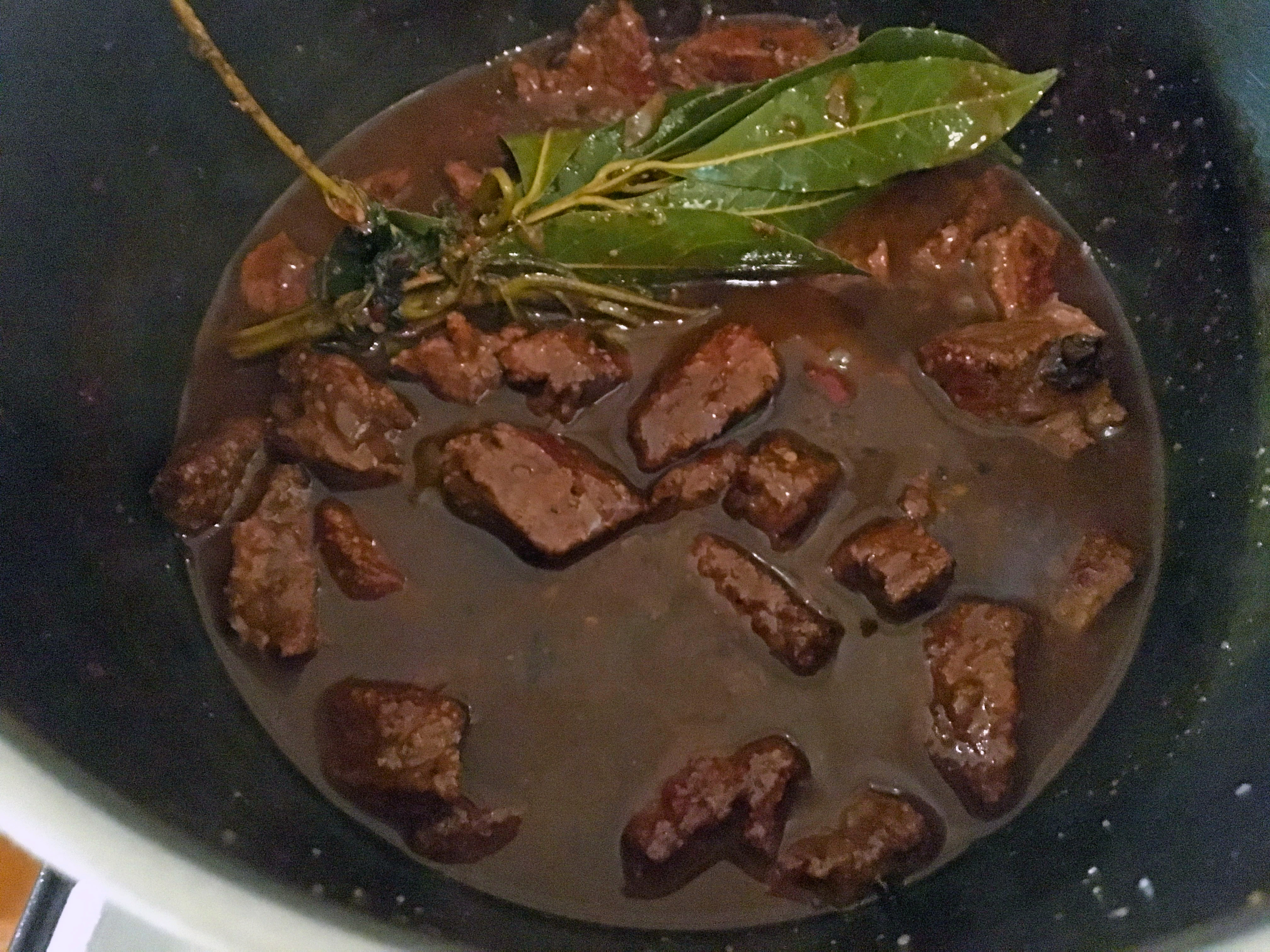
I’m on record saying we need to eat more game this year, so I’m putting my money where my mouth is. I’m also working a more indigenous angle here and taking the recipe back to its roots — well, as much as I can in the middle of Europe, anyway.
First, I boil some water and soak a large pasilla chili and some arbols. While that’s soaking, I dice three shallots and cube about two pounds of venison tenderloin. The meat should be clear of any fascia.

After about 15 minutes, I remove the chilis from the water bath and give them a rough dice. I add the chilis, a splash of the bath water, and two cloves of garlic to a blender. I hit the button and create a nice chili paste. It should be about the same consistency as a sambal oelek.


Once everything is ready, I dredge the venison in a few tablespoons of cornmeal, salt, and pepper, then sear them off in batches in pork lard. After the venison is all seared, there should be a nice fond on the bottom of the stockpot. I add the shallots and sweat them with a little beef broth to bring up that fond.

I add in the chili paste and shock it on the bottom of the pan for about a minute before adding the venison back in with a liter of beef broth. Lastly, I add a sort of makeshift bouquet garni of fresh bay leaf, fresh oregano, and fresh sage. I let that simmer until the liquid is halved and then it’s ready.
Ideally, you can let this slowly bubble away all day.

The Buffalo Cheese Corn Cakes

This is the coup de grâce right here. I never knew how much I loved corn cakes until I loaded them with cheese. Now, they’re my everything.
This recipe is straightforward. One cup of cornmeal, 1/2 cup of corn flour, a tablespoon of baking powder, a pinch of salt, and a couple splashes of whole milk make the base. It should be thick enough to just hold a bit of a form. I then add in about 150 grams (five ounces) of funky and grassy buffalo milk cheese. It’s medium firm and grates like a cheddar. I fold that into the cake mix.

Next, I heat up my tortilla pan with some pork lard and fry up the cakes. Done. The cheese makes them extra crispy on the outside and the fat makes the corn cake super smooth and luscious on the inside.

The Presentation

I use a slice of the cheesy corn cake as a barrier in the bowl. On one side goes the venison chili and on the other side goes the beans. I garnish everything with some fresh cilantro and lime and my pickled shallots and chilis. I have a pickle brine I’ve been using for ages and just adding more chilis and onions as I go along.
The brine itself makes the best bloody marys, but I digress.

The venison chili is a delight. The meat is so soft you can cut it with a spoon, but it’s not stringy or dry. It’s super moist, firm, and lush. The chili stew is deeply spicy with heavy earthy tones and smokiness. The crispy and cheesy corn cake makes for a perfect crouton to absorb some of the chili heat. The beans are little savory bombs of wonderfulness.
I squirt on some lime juice and everything ends up kinda getting mixed together with the acidity of the pickles popping every couple bites. This chili is straight up hot fire.
The venison was spicy to the point of having strong heat, but the taste of the meat still shone through (my eight-year-old ate the venison if that’s any indication of the heat, but he loves spicy things at the moment). As with most meals from this part of the culinary world, the real heat is 100 percent adjustable according to your own use of the pickled jalapenos and habaneros. As you can see, I went hot.

Vince on Zach’s Chili:
I’ll be honest, I appreciated the history lesson. It looks like you put an entire tree worth of spices in there, but you sort of want those tree spices with venison. I wholeheartedly support cheesy cornbread, and flat-cooked cornbread (think of the surface area!). I want to rip on you for “the texture of sambal oelek,” but I can’t deny knowing what that is, so… you seem to know your audience.
As a bean enjoyer, I also understand how precious some people are about putting beans in their chili (looking at you, Texans) so I appreciate your “separate but equal” bean solution (maybe it’s more of a two-state solution?). I still want to add some cheese, but yeah I’d eat that.
Steve on Zach’s Chili:
If we were on Top Chef, and Vince was writing his world famous recaps, he’d say of Zach: “Finally, you made Native American food! Not only that, it A) felt accessible and B) made sense for the challenge. Well played, buddy, well played.” And your playing is awesome — just rustic enough, but still refined. Bravo!
My #1 gripe: That venison is the leanest meat I’ve ever seen. Then you re-added fat, via pork lard. So… why not just use pork if you wanted pork fat? Or something lean but not ultra-lean, that still felt traditional and fit with the cheese you used? Something like… BUFFALO! In any event, I’d bet dollars to donuts that your meat got stringy. Worse than that, instead of embracing the leanness you just added back all the fat from a different animal.
Also, a question: Is cilantro the right garnish for that plate? I mean, you have bay, oregano, and sage in your chili. Those are consistent flavor-wise with the herbs I’ve tasted in traditional Native food. I can’t imagine a scenario where cilantro goes with sage (the cilantro-sage crossover potential seems very small) and the “Farmer’s Daughter” doesn’t recommend it, BUT considering that what I know about Native food comes from editing your excellent writing on the subject, and the restaurants I’ve visited based on your recs… it seems precarious to tell you this is a bad idea. I guess what I’m saying is: “Benefit of the doubt for the win!”






